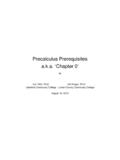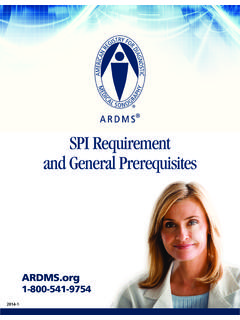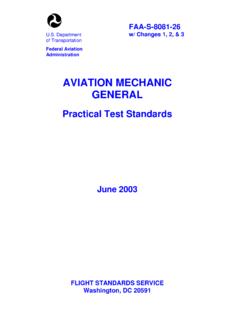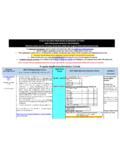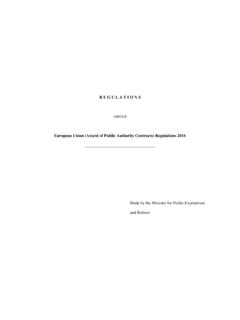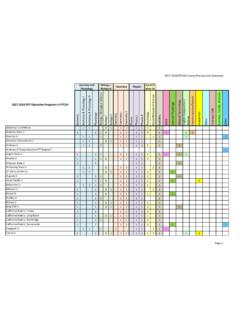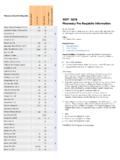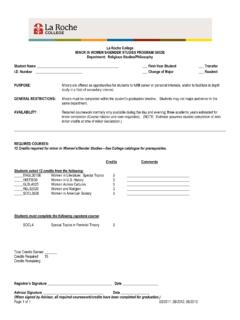Transcription of Precalculus Prerequisites a.k.a. ‘Chapter 0’
1 Precalculus Chapter 0 byCarl Stitz, Zeager, Community College Lorain County Community CollegeAugust 16, 2013 Table of Contents0 Basic Set Theory and Interval Some Basic Set Theory Sets of Real Real Number Linear Equations and Linear Linear Absolute Value Equations and Absolute Value Absolute Value Polynomial Polynomial Addition, Subtraction and Polynomial Long Solving Equations by Quadratic Rational Expressions and of Radicals and Rationalizing Denominators and Complex Relations and Sets of Real Numbers and the Cartesian Coordinate The Cartesian Coordinate Distance in the Graphs of Introduction to Function Modeling with Function Graphs of General Function Linear and Quadratic Linear Absolute Value of Quadratic
2 Inequalities with Absolute Value and Quadratic Polynomial Graphs of The Factor Theorem and the Remainder Real Zeros of For Those Wishing to use a Graphing For Those Wishing NOT to use a Graphing Complex Zeros and the Fundamental Theorem of Rational Introduction to Rational Graphs of Rational Rational Inequalities and of Contents5 Further Topics in Function Inverse Other Algebraic Exponential and Logarithmic Introduction to Exponential and Logarithmic Properties of Exponential Equations and Logarithmic Equations and Applications of Exponential and Logarithmic Applications of Exponential Applications of Hooked on Introduction to of Systems of Equations and Systems of Linear Equations: Gaussian Systems of Linear Equations: Augmented Matrix Systems of Linear Equations.
3 Matrix Determinants and Cramer s Definition and Properties of the Cramer s Rule and Matrix Partial Fraction Systems of Non-Linear Equations and Sequences and the Binomial Summation Mathematical Selected The Binomial of Contents10 Foundations of Angles and their Applications of Radian Measure: Circular The Unit Circle: Cosine and Beyond the Unit The Six Circular Functions and Fundamental Beyond the Unit Trigonometric Graphs of the Trigonometric Graphs of the Cosine and Sine Graphs of the Secant and Cosecant Graphs of the Tangent and Cotangent The Inverse Trigonometric Inverses of Secant and Cosecant: Trigonometry Friendly Inverses of Secant and Cosecant.
4 Calculus Friendly Calculators and the Inverse Circular Solving Equations Using the Inverse Trigonometric Trigonometric Equations and Applications of Applications of Harmonic The Law of The Law of of Polar Graphs of Polar Hooked on Conics Rotation of The Polar Form of Polar Form of Complex The Dot Product and Parametric of ContentsChapter 0 PrerequisitesThe authors would like nothing more than to dive right into the sheer excitement of , experience - our own as well as that of our colleagues - has taught us that is it bene-ficial, if not completely necessary, to review what students should know before embarking on aPrecalculus adventure.
5 The goal of Chapter0is exactly that: to review the concepts, skills andvocabulary we believe are prerequisite to a rigorous, college-level Precalculus course. This reviewis not designed to teach the material to students who have never seen it before thus the presenta-tion is more succinct and the exercise sets are shorter than those usually found in an IntermediateAlgebra text. An outline of the chapter is given (Basic Set Theory and Interval Notation) contains a brief summary of the set theoryterminology used throughout the text including sets of real numbers and interval (Real Number Arithmetic) lists the properties of real number (Linear Equations and Inequalities) focuses on solving linear equations and linearinequalities from a strictly algebraic perspective.
6 The geometry of graphing lines in the plane isdeferred until (Linear Functions). (Absolute Value Equations and Inequalities) begins with a definition of absolute valueas a distance. Fundamental properties of absolute value are listed and then basic equations andinequalities involving absolute value are solved using the distance definition and those value is revisited in much greater depth in (Absolute Value Functions). (Polynomial Arithmetic) covers the addition, subtraction, multiplication and division ofpolynomials as well as the vocabulary which is used extensively when the graphs of polynomialsare studied in Chapter3(Polynomials).
7 (Factoring) covers basic factoring techniques and how to solve equations using thosetechniques along with the Zero Product Property of Real (Quadratic Equations) discusses solving quadratic equations using the technique of completing the square and by using the Quadratic Formula. Equations which are quadratic inform are also know, the stuff students mess up all of the time like fractions and negative signs. The collection is close toexhaustive and definitely exhausting! (Rational Expressions and Equations) starts with the basic arithmetic of rational ex-pressions and the simplifying of compound fractions.
8 Solving equations by clearing denominatorsand the handling negative integer exponents are presented but the graphing of rational functionsis deferred until Chapter4(Rational Functions). (Radicals and Equations) covers simplifying radicals as well as the solving of basicequations involving (Complex Numbers) covers the basic arithmetic of complex numbers and the solvingof quadratic equations with complex Basic Set Theory and Interval Basic Set Theory and Interval Some Basic Set Theory NotionsLike all good Math books, we begin with a a well-defined collection of objects which are called the elements ofthe set.
9 Here, well-defined means that it is possible to determine if something belongs to thecollection or not, without collection of letters that make up the word smolko is well-defined and is a set, but thecollection of the worst Math teachers in the world isnotwell-defined and therefore isnota general, there are three ways to describe sets and those methods are listed to Describe Verbal Method:Use a sentence to define the Roster Method:Begin with a left brace { , list each element of the setonly onceand then end with a right brace } . Set-Builder Method:A combination of the verbal and roster methods using a dummy variable such example, letSbe the set describedverballyas the set of letters that make up the word smolko.
10 Arosterdescription ofSis{s,m,o,l,k}. Note that we listed o only once, eventhough it appears twice in the word smolko . Also, theorderof the elements doesn t matter,so{k,l,m,o,s}is also a roster description ofS. Moving right along, aset-builderdescriptionofSis:{x|xis a letter in the word smolko }. The way to read this is The set of elementsxsuch thatxis a letter in the word smolko . In each of the above cases, we may use the familiarequals sign = and writeS={s,m,o,l,k}orS={x|xis a letter in the word smolko }.Notice thatmis inSbut many other letters, such asq, are not inS.
